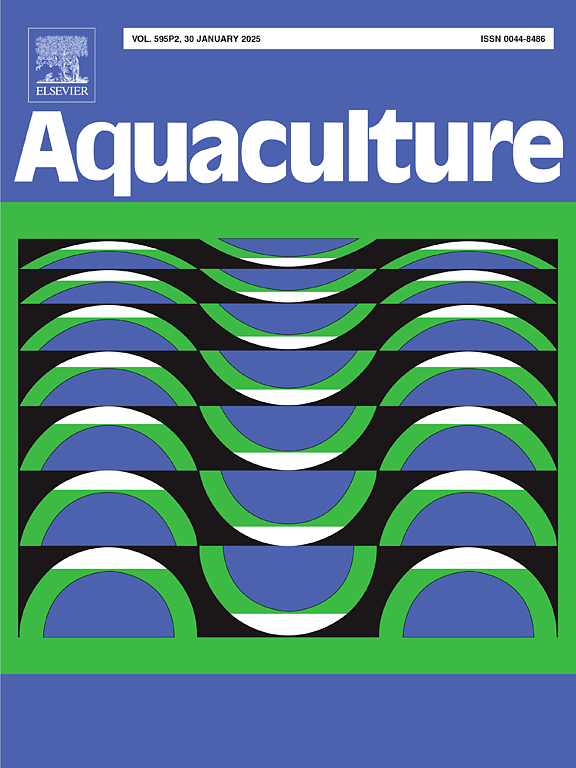IF 3.9
1区 农林科学
Q1 FISHERIES
引用次数: 0
摘要
鳞鱼(Cyclopterus lumpus)等清洁鱼被用于鲑鱼养殖,以控制海虱的侵扰。以前的实验室研究表明,环境强化(EE)可用于在囫囵鱼遇到活鲑鱼之前使其习惯,从而促进其更早地开始清洁行为。本研究将 EE 应用于商业生产,并报告了 2020 年至 2022 年期间进行的四次试验的结果。在将幼年鳞鱼放入三文鱼网箱之前,先让它们在生产设施中接触栩栩如生的三文鱼模型七天。在此期间,附着在三文鱼模型上的情况显著增加。在接触模型期间,鳞鱼没有表现出任何外在的应激迹象。不过,端脑中的血清素能和多巴胺能活动发生了变化。这可能与在其他清洁鱼类中观察到的社会参与调整有关。在部署后的第 2 天和第 7 天,对胃内容物(n = 523)进行了分析,结果显示,与对照组相比,在第 2 天,胃中有虱子的 EE 鲮鱼比例明显较高,但在第 7 天则没有发现。此外,只有对照组在投放后体重有所下降。最后,在投放后第七天,发现富集组端脑中的血清素能活动低于对照组,这可能与焦虑/压力水平较低有关。这些研究结果表明,EE 会影响与社会交往有关的大脑调节,从而对虱子的消耗产生间接的积极影响。结论是,在鲑鱼网箱中投放 EE 后,EE 可能会促使囫囵鱼更快地开始消耗虱子,而且这种影响具有时间性。本文章由计算机程序翻译,如有差异,请以英文原文为准。
Environmental enrichment of lumpfish (Cyclopterus lumpus) during rearing increases sea lice consumption in commercial Atlantic salmon (Salmo salar) farming
Cleaner fish such as the lumpfish (Cyclopterus lumpus) are used in salmon farming for controlling infestations of sea lice. Previous laboratory studies suggest that environmental enrichment (EE) can be used to habituate lumpfish before encountering live salmon and thus promote earlier onset of cleaning behaviour. This study applied EE in commercial production, and reports findings from four trials conducted from 2020 to 2022. Juvenile lumpfish were exposed to life-like salmon models for seven days at the production facility prior to deployment in salmon net pens. During this period, the incidence of physically attaching to the salmon models significantly increased. Lumpfish did not express any outward signs of stress during exposure to the models. However, alterations in serotonergic and dopaminergic activity in the telencephalon was detected. This was potentially related to adjustments for social engagement as observed in other cleaner fish species. Stomach contents (n = 523) were analysed on day two and day seven after deployment and revealed a significantly higher proportion of EE lumpfish with lice in their stomachs compared to control, on day two but not on day seven. Furthermore, weight loss post deployment was observed only in the control group. Finally, serotonergic activity in the telencephalon of the enriched group was found to be lower than in the control group on day seven after deployment, which could be related to a lower level of anxiety/stress. These findings suggest that EE influences brain regulation related to social interaction with indirect positive effects on lice consumption. It is concluded that EE may encourage lumpfish to begin consuming lice more quickly after deployment in salmon net pens, and that the effect is temporal.
求助全文
通过发布文献求助,成功后即可免费获取论文全文。
去求助
来源期刊

Aquaculture
农林科学-海洋与淡水生物学
CiteScore
8.60
自引率
17.80%
发文量
1246
审稿时长
56 days
期刊介绍:
Aquaculture is an international journal for the exploration, improvement and management of all freshwater and marine food resources. It publishes novel and innovative research of world-wide interest on farming of aquatic organisms, which includes finfish, mollusks, crustaceans and aquatic plants for human consumption. Research on ornamentals is not a focus of the Journal. Aquaculture only publishes papers with a clear relevance to improving aquaculture practices or a potential application.
 求助内容:
求助内容: 应助结果提醒方式:
应助结果提醒方式:


